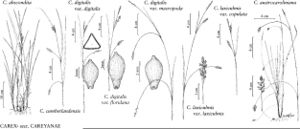Difference between revisions of "Carex laxiculmis var. copulata"
Rhodora 8: 183. 1906.
Basionym: Carex digitalis var. copulata L. H. Bailey Mem. Torrey Bot. Club 1: 47. 1889
Synonyms: Carex ×copulata (L. H. Bailey) Mackenzie
FNA>Volume Importer |
FNA>Volume Importer |
(No difference)
| |
Revision as of 21:11, 16 December 2019
Leaves usually bright green; widest blade 5.3–8.3 mm wide. Longest staminate spike 6–20(–23) mm.
Phenology: Fruiting spring–early summer.
Habitat: Low, wet, deciduous or mixed deciduous-evergreen forests, mesic slopes to along edges of springs, seeps, and streams, usually clay soils
Elevation: 0–1000 m
Distribution

Ont., Ala., Ark., Ill., Ind., Iowa, Ky., Mich., Mo., N.C., Ohio, Tenn., Va., W.Va., Wis.
Discussion
Carex laxiculmis var. copulata has been treated as a variety of C. digitalis or C. laxiculmis, as a distinct species, and as a hybrid between C. digitalis and C. laxiculmis. Regular pairing during metaphase-I indicates that C. laxiculmis var. copulata is not a by-product of hybridization (R. F. C. Naczi 1999). In lateral spikes, a proximal sterile scale or scale subtending a staminate flower clearly places the affinity of this variety with C. laxiculmis rather than C. digitalis (C. T. Bryson 1980).
Selected References
None.
Lower Taxa
None.
